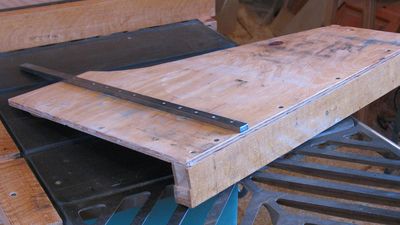Sliding table substitute
I'm used to working with a sliding table from my dad's workshop, so I wanted something like that for my table saw in my shop. There's various after market sliding table contraptions that can be bolted onto a table saw, but aside from being costly I didn't really find any of them confidence inspiring.After I built mine, I found that such a contraption is often called a "panel saw". The contraption has a 3/8 x 5/8 cold rolled steel flat bar screwed to the bottom, which fits into the slot for the miter gauge of the same size. I bought the flat bar from the Metal Supermarket. To attach it to the plywood, I cut threads into the flat bar, and screwed it in with countersink machine screws from the top.

The crosscut fence part of this device serves both as a crosscut fence, as well as a handle. Its made of a sandwich of a quarter inch white oak on either side, with pine in the middle. Came from a very old door. Its screwed onto the top of the plywood, with screws from the bottom.
When making one of these, don't go too thick on the plywood, because it will cut down on your ultimate depth of cut. Make the board extend past the saw blade when you initially assemble it, and then cut the sliding table off with the table saw. That way, the plywood ends as close to the blade as possible. Having the plywood go very close to the blade cuts down on chipping and tearout on crosscuts, which is handy.
It also helps to varnish a jig like this, especially the relatively soft plywood. The varnish fills up the pores, and in general makes the surface harder and more wear resistant.
Because my table saw is only a 9" table saw, it doesn't cut overly deep, and especially with this gadget, I sometimes run out of depth of cut, such as when cutting off a table leg. In those cases, I usually just push the work piece against the back of the crosscut fence, so that the work piece is resting directly on the cast iron table.
I have since written a more detailed article about building a table saw crosscut sled like this one.